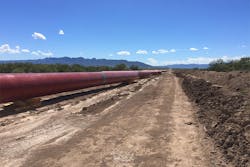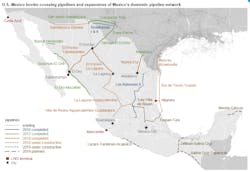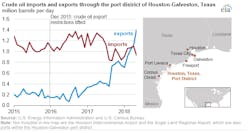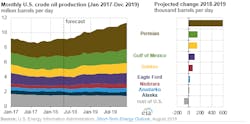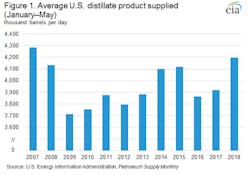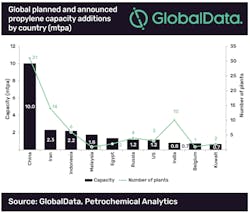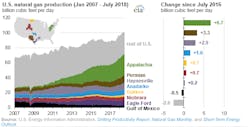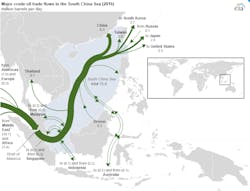U.S. natural gas pipeline exports increase amid Mexican pipeline expansions
U.S. natural gas pipeline exports to Mexico are increasing because of development of cross-border pipeline capacity. Exports averaged 4.2 billion cubic feet per day (Bcf/d) in 2017 and 4.4 Bcf/d in the first five months of 2018. Gas exports by pipeline to Mexico exceeded 5 Bcf/d for the first time in July 2018, according to data acquired by Genscape. By the end of 2018, six major pipelines are planned to open in Mexico, furthering the country’s plan for expansion of its natural gas infrastructure.
Seventy-five percent of U.S. natural gas exports to Mexico come from southern Texas, which averaged 3.2 Bcf/d in 2017 and 3.3 Bcf/d during the first five months of 2018. Construction delays on pipelines on the Mexican side of the border slowed down pipeline capacity from West Texas.
Graphic courtesy of EIA
Port district of Houston-Galveston became net exporter of crude oil in April
The port district of Houston-Galveston in Texas for the first time in April started exporting more crude oil than it imported. The increase in exports is a result of the lifting of restrictions on U.S. crude oil exports in 2015. In April, exports surpassed imports by 15,000 barrels per day (b/d). In May, total U.S. crude oil exports rose to a record of 2 million b/d and since mid-2017, the port district of Houston-Galveston accounted for more than half of total exported U.S. crude oil.
Crude oil imported into this area largely came from South America, the Middle East and Mexico from refineries better-suited for processing heavier crude oil. U.S. exports are of a lighter grade and usually go to Canada, the U.K., Italy and China.
Graphic courtesy of EIA
Permian region expected to push U.S. crude oil production through 2019
The EIA predicted U.S. crude oil will average 10.7 million b/d in 2018 and 11.7 million b/d in 2019. If this happens, the levels will exceed the previous record of 9.6 million b/d in 1970. The Permian region is expected to contribute 3.3 million b/d in 2018 and 3.9 million b/d in 2019. Lower wellhead prices resulted in slower crude oil production in this region in 2019 compared to 2018 but will still account for more than half of U.S. production.
Graphic courtesy of EIA
U.S. distillate demand reaches highest since 2017
U.S. demand for distillate fuel oil is at its highest level in more than a decade. In the first five months of 2018, U.S. distillate fuel oil product supplied average 4.2 million b/d — a 270,000 b/d increase over 2017 and the highest since 2007. As a result, distillate exports are down from 2017. U.S. inventories have also declined.
In the first five months of 2018, average retail diesel fuel price was 51 cents per gallon higher than the same period in 2017. Brent crude oil price also increased by 41 cents a gallon compared to the same time in 2017. That increase is partly responsible for the price increase in diesel fuel. The diesel crack spread on the U.S. Gulf Coast increased 18 cents per gallon from the first five months of 2016 to the same period in 2018.
As of May 2018, U.S. distillate inventories were 115.2 million barrels, the lowest level for the month of May since 2008. The growth in distillate usage is mainly because of an increased trucking industry, which is the largest domestic consumer of distillate fuel.
Graphic courtesy of EIA
China to lead propylene capacity growth though 2026
According to data acquired by GlobalData, China will continue to lead the global propylene capacity growth from 121.3 million tons per annum (mtpa) in 2017 to 1481 mtpa in 2026. In Asia, China is poised to have a total capacity of 10 mtpa by 2022 with 31 announced propylene plants. The Middle East has 14 planned plants and a capacity of 2.3 mtpa, Russia is forecast to have a capacity of 1.2 mtpa by 2022 and the U.S. is expected to have a mtpa of 1.2 over the next eight years.
Graphic courtesy of GlobalData
Permian, Haynesville, Appalachia to propel natural gas production
Gross production of natural gas has been climbing for more than a decade and has been 10 percent higher in recent months in comparison to similar months in 2017. Driving regions of this growth include the Appalachian Basin, the Permian Basin and the Haynesville Shale. These regions account for almost 50 percent of total production. The increase is attributed to new drilling and completion techniques and the fact that crude oil production in the Gulf region has dropped off. Older wells in the Gulf tend to be more natural gas while the newer wells are more of an oil-rich nature.
Graphic courtesy of EIA
A third of global maritime crude oil trade travels through South China Sea
In 2016, the South China Sea transported 30 percent of global maritime crude oil trade, which accounted for around 15 million b/d. More than 90 percent of that transported crude oil volume went through the Strait of Malacca, the shortest sea route between Africa and Asia. Routes for the Middle East accounted for 70 percent of South China Sea crude oil shipments in 2016 with Saudi Arabia being the largest source of crude oil. The three largest crude oil importers through the South China Sea in 2016 were South Korea, China and Japan.
Graphic courtesy of EIA
